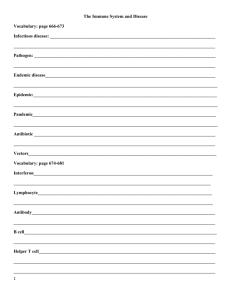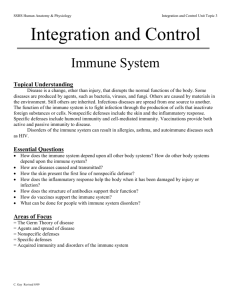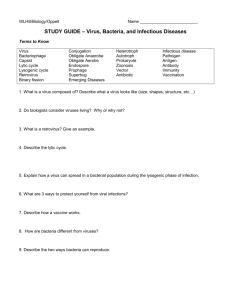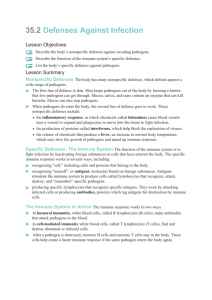Ch.40 - Jamestown School District
advertisement
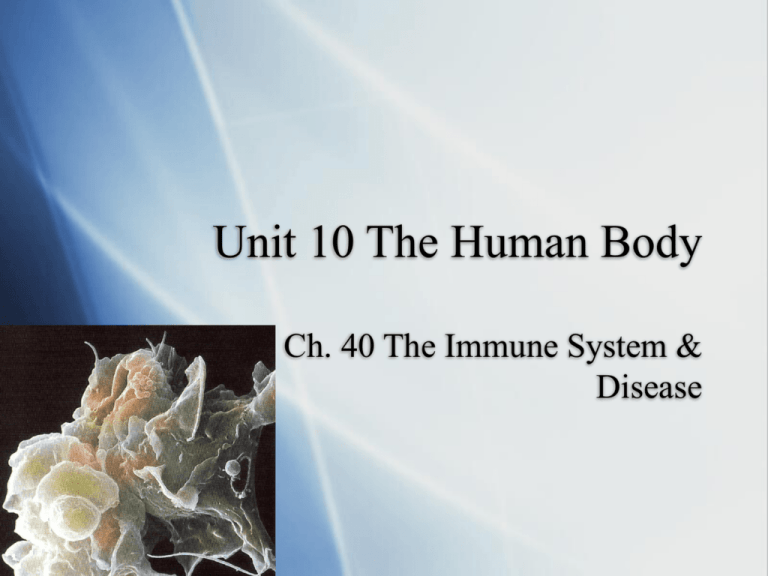
Unit 10 The Human Body Ch. 40 The Immune System & Disease Infectious Disease Disease - any change, other than an injury, that disrupts homeostasis Some diseases are produced by agents like: bacteria, viruses, & fungi Pathogens Pathogens - disease-causing agents Diseases caused by pathogens are generally infectious disease The Germ Theory of Disease For thousands of years, people believed that diseases were caused by curses, evil spirits, or night vapors Chemist, Louis Pasteur & bacteriologist, Robert Koch, concluded that diseases were caused by different types of microorganisms, called germs Koch’s Postulates 1. The pathogen should always be found in the body of a sick organism, not in a healthy one 2. The pathogen must be isolated & grown in the lab in pure culture Koch’s Postulates 3. When the cultured pathogens are placed in a new host, they should cause the same disease that infected the original host 4. The injected pathogen should be isolated from the second host. It should be identical to the original pathogen. Agents of Disease Some pathogens, including viruses & some bacteria, destroy cells as they grow Other bacteria release toxins that harm an organism Agents of Disease Still others, especially parasitic worms, produce sickness when they block the flow of blood, remove nutrients from the digestive system, & disrupt other bodily functions How Diseases Are Spread Some infectious diseases are spread from 1 person to another through coughing, sneezing, or physical contact Other infectious diseases are spread through contaminated water or food How Diseases Are Spread Still others are spread by infected animals Vectors - animals that carry pathogens from person to person Fighting Infectious Diseases Antibiotics - compounds that kill bacteria without harming the cells of the human or animal hosts The Immune System The function of the immune system, is to fight infection through the production of cells that inactivate foreign substances or cells - immunity The immune system includes 2 general categories of defense mechanisms: nonspecific & specific defenses Nonspecific Defenses Nonspecific defenses do not discriminate between 1 threat & another These defenses include physical & chemical barriers Nonspecific Defenses First Line of Defense: The function is to keep pathogens out of the body This role is carried out by skin, mucus, sweat, & tears Your body’s most important nonspecific defense is the skin Nonspecific Defenses Second Line of Defense: If pathogens enter your body, they multiply quickly, releasing toxins into your tissues When this happens, it activates the inflammatory response Inflammatory response - a reaction to tissue damage caused by injury or infection Nonspecific Defenses Second Line of Defense: When pathogens enter the body, phagocytes (white blood cells), move into the area & engulf (eat) the pathogens Inflammatory Response Nonspecific Defenses Second Line of Defense: The immune system also releases chemicals that increase the core body temp. - Fever An elevated body temp. slows down or stops the growth of some pathogens Fever & increased # of WBC’s indicates an infection Nonspecific Defenses Second Line of Defense: Sometimes, virus-infected cells produce a group of proteins that help other cells resist viral infection Interferons - “interfere” with the growth of viruses; they inhibit the synthesis of viral proteins in infected cells & help block viral replication Specific Defenses If a pathogen gets past the body’s nonspecific defenses, the immune system reacts with specific defenses that attack that particular disease-causing agent - Immune response Specific Defenses Antigen - a substance that triggers this response, includes: viruses, bacteria, & other pathogens 2 types of lymphocytes recognize specific antigens: B lymphocytes (B cells) & T lymphocytes (T cells) Specific Defenses B cells provide immunity against antigens & pathogens in the body fluids - Humoral immunity T cells defend against abnormal cells & pathogens inside living cells - Cellmediated immunity Specific Defenses Humoral Immunity: When a pathogen invades the body, it is recognized by B cells These B cells grow & divide rapidly, producing large #’s of plasma cells & memory B cells Specific Defenses Humoral Immunity: Plasma cells release antibodies Antibodies - proteins that recognize & bind to antigens, they are carried in the bloodstream to attack the pathogen causing the infection Once the body has been exposed, memory B cells remain capable of producing antibodies specific to that pathogen Specific Defenses Cell-mediated Response: T cells provide defense against abnormal cells & pathogens inside living cells Specific Defenses Although killer T cells are helpful in the immune system, they make acceptance of organ transplants difficult Your immune system damages & destroys the transplanted organ The process is known as rejection Acquired Immunity Vaccination - the injection of a weakened pathogen to produce immunity Active immunity - immunity produced by the body’s reaction to a vaccine Passive immunity - when antibodies produced by other animals are injected into the bloodstream Acquired Immunity Active Immunity: It appears after exposure to an antigen, as a result of the immune response Active immunity may develop as a result of natural exposure to an antigen (fighting an infection) or from deliberate exposure to the antigen (through a vaccine) Acquired Immunity Passive Immunity: It only lasts a short time because eventually, the body destroys the foreign antibodies Like active immunity, it may develop naturally or by deliberate exposure Acquired Immunity Passive Immunity: 1 kind of natural immunity occurs when the mother passes antibodies to the fetus through the placenta, or through breast milk Immune System Disorders There are 3 different types of immune system disorders: allergies, autoimmune diseases, & immunodeficiency diseases Allergies Allergies - overreactions of the immune system to antigens Common allergies include: pollen, dust, mold, & bee stings Allergies When allergy-causing antigens enter the body, they attach themselves to cells that initiate the inflammatory response Those cells release chemicals called histamines Allergies Histamines - chemicals that increase the flow of blood & fluids to the surrounding area They also increase mucus production, resulting in sneezing, watery eyes, runny nose, & other irritations Asthma Asthma - a chronic respiratory disease where the air passages become narrower than normal It causes wheezing, coughing, & difficulty in breathing Asthma attacks can be triggered by infections, exercise, stress, etc. Autoimmune Diseases Autoimmune disease - when the immune system makes a mistake & attacks the body’s own cells Multiple sclerosis is an example where antibodies destroy the functions of the neurons in the brain & spinal cord AIDS, an Immunodeficiency Disease 1 type of immunodeficiency disease, the immune system fails to develop normally The 2nd type of immunodeficiency disease is AIDS AIDS, an Immunodeficiency Disease AIDS results from a viral infection (HIV) that destroys helper T cells As the # of helper T cells declines, the normal immune response breaks down When a person has AIDS, they die from the inability to fight off infection, like the flu, a cold, etc. AIDS, an Immunodeficiency Disease AIDS - Acquired ImmunoDeficiency Syndrome HIV - Human Immunodeficiency Virus (causes AIDS) HIV Infection AIDS, an Immunodeficiency Disease There are 4 main ways HIV can be transmitted: 1. Sexual intercourse with an infected individual 2. Shared needles or syringes 3. Contact with blood or blood products 4. Infected mother to child, during pregnancy, birth, or breast-feeding AIDS, an Immunodeficiency Disease The only no-risk behavior with respect to HIV & AIDS is abstinence (no sex) At the present time, there is no cure for AIDS The Environment & Your Health Risk factor - factors that have potential to affect health in a negative way Environmental factors that can affect your health include air & water quality, poisonous wastes in landfills, & exposure to solar radiation Air Quality Carbon monoxide is found in automobile exhaust & cigarette smoke When carbon monoxide is inhaled, it prevents hemoglobin from carrying oxygen Air Quality Lead is a particulate found in the air that can poison the liver, kidneys, & nervous system Lead poisoning in babies & young children can result in slow mental development Air Quality Asbestos is another particulate that may be carried in the air It was commonly used for insulation, & when inhaled, it can cause lung cancer Water Quality Water can carry biological & chemical pollutants Biological pollutants, like human & animal wastes, can contain bacteria or viruses that cause cramps, vomiting, diarrhea, or diseases like hepatitis or cholera Water Quality Some chemical pollutants cause organ damage Others interfere with development of organs & tissues, causing birth defects Still others can damage DNA, causing normal cells to become cancerous Bioterrorism Bioterrorism involves treating pathogens to maximize their ability to infect & cause disease Anthrax is a disease common in cattleranching areas, not life-threatening The spores can be treated to be spread in the air & inhaled, producing a fatal infection Cancer Cancer is a life-threatening disease where cells multiply uncontrollably & destroy healthy tissue Cancer cells are the bodies own cells Cancer Cancer begins when cells grow & reproduce uncontrollably, resulting in a tumor Tumor - the formation of a mass of growing tissue Cancer Benign tumors are NOT cancerous Malignant tumors are cancerous, & are capable of invading & destroying surrounding healthy tissue Cancer Cancers are caused by defects in the genes that regulate cell growth & division The genetic defects may be inherited, caused by viruses, or result from mutations in DNA that are produced by chemicals, radiation, or occur spontaneously Cancer Carcinogens - chemical compounds that are known to cause cancer by triggering mutations in the DNA of normal cells Some of the most powerful chemical carcinogens are found in tobacco smoke Cancer The best way to fight cancer is by protecting your DNA from agents that cause cancer Regular exercise & a balanced diet, regular checkups, self-examinations, etc., can all help reduce your risk Maintaining Health To keep your immune system working efficiently, practice behaviors that reduce your exposure to pathogens & maintain overall good health Healthful behaviors include eating a healthy diet, exercise, get plenty of rest, abstaining from harmful activities, & have regular checkups

